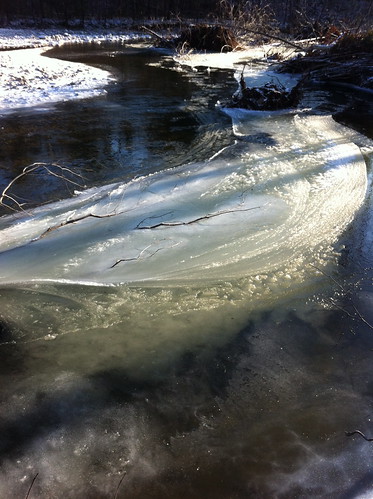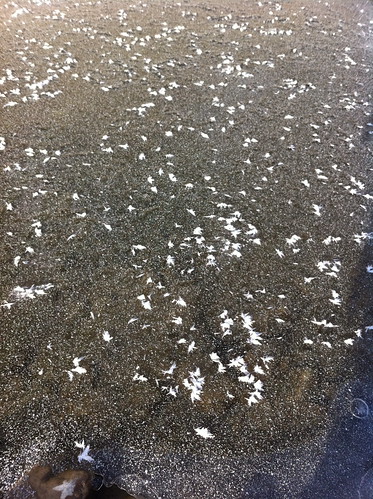When temperatures are very cold, but water is moving too much to freeze normally, frazil ice formation can occur. Frazil ice is a mass of ice crystals, resembling slush, that often forms in fast-moving water, especially downstream from rapids and waterfalls that splash mist and water into the frigid air where it can freeze. It then falls back into the river and moves along, creating an effect that resembles a watery 'slushie'.
In extreme situations, as found at the base of Yosemite Falls in the mountains of California, frazil ice can accumulate in huge amounts. It can shift the course of rivers and destroy human-created structures as it accumulates and freezes to any stationary surface. There isn't much risk of frazil ice related flooding in the Middlebury River right now because the water level is quite low, but it does lead to some fascinating formations and has a definite influence on the way the river moves through its channel.
Frazil ice forms in fast-moving waters at temperatures below around 20 to 25 degrees Fahrenheit - both of which are often present along the Middlebury River in the winter. The lack of snowfall this year also makes the frazil ice easy to observe (snow can also fall into water and create formations similar to frazil ice). As time passes, some of the frazil ice flowing by downed trees and riverbanks freezes to their edge, allowing for a slow buildup of ice in the river. After extended cold spells, most of the river ends up covered with unmoving frazil ice, but short thaws may dislodge or melt much of these fragile formations. The fluctuating temperatures that have occurred this winter have created good conditions for observing this process.

I poked the ice in the foreground here with a very long stick. Under the surface it was soft, like cotton candy or jelly. At the surface it was crusty, but even a small cobble tossed into the surface would 'splat' and sink in. It's never safe to walk on deposits of frazil ice, no matter how cold the weather gets. Also note the little 'pancakes' of frazil ice in the background floating down the river.
Here are two pictures taken before and after last night's cold snap:


Note that by this morning, there was only a small channel of open water left. It's supposed to remain quite cold tonight, though not as cold as last night, and I suspect by tomorrow morning this part of the river may be completely covered with frazil ice.
This area of slow-moving water froze over in the night and created little 'frost flowers':

There may be another thaw on the way for Saturday, but it won't be warm enough to get rid of all this ice. In general, the ice formations on the river should be increasing in cover for the next couple of months, and it will be fascinating to watch this process.

Very nice images and description- I never knew the term for the ice that forms on running water, but now I do! Cheers.
ReplyDelete